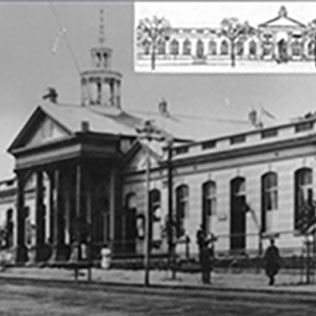Vaal Martiens Pretorius, of the farm Paardekraal, gave the land to the government. The town to be Krugersdorp after his friend Paul Kruger, the presidents of the ZAR. The town surveyed in two 576 stands, the first 200 stands sold by public auction to the gold-diggers at an auction on 31 October 1887, and there a 99-year leasehold agreement. The Government block today is the Magistrates Court (Museum), and the Post Office.

Old Magistrates Building
The classic style designed by the architect, Zytske Wierda, the state architect. The cornerstone unveiled by Pres. Paul Kruger on the 18 September 1890. This magistrate’s court remained in service until 17 June 1973.
The Magistrates Museum opened in 19 January 1995. The Museum of the peoples and the culture of Krugersdorp.
Following the Anglo Boer war, 27/02/1881, the Boers and the commandos returned to their republics.
In 1853, a prospector, Pieter Jacob Marais, return to the ZAR. He had been prospecting in California and Australia.
He discovered alluvial gold near the confluence of the Crocodile and Jukskei rivers.
This followed in 1867 – the discovery of diamonds in Kimberley.
The alluvial gold rush in 1872 in Pilgrim’s Rest in Mpumalanga.
In 1880 mining in the Krugersdorp area had begun on a small scale.
The discovery in 1886 on the Witwatersrand Gold Reef changed everything. A time of intense activity, a huge influx of foreigners (Uitlanders). Fortune seekers who followed the discoveries of gold and diamonds the world over.
This was the biggest gold find ever, it required capital and machinery. The start of underground mining.
This was not the only mining taking place. The mining of Lime in the caves of the Cradle of Humankind was big. Lime, one of the components used in the refining of gold.
The mining of Guano in the caves was taking place. The caves are a haven for Bat colonies. The guano made for very good fertilizer on the farms.
Paul Kruger’s government resented this growing population of foreigners. Not understanding the value of the gold find and hoping that the mining would disappear. And the gold remain in the ground. This did not happen with the increasing mining population. Threatening to outnumber the citizens in the ZAR.
The government of the day decided to tax the Uitlanders. Limiting their rights to be in the Republic and not process any claims of non-citizenship. This led to a lot of animosity between the government and the miners.
The government benefited from the taxes that they extracted from the mining activities. This antagonized the Randlords, the mining hierarchy who raised the finance, bought the gold rights and now need to get on with the mining, were being stopped by the government of the day.
Jameson Raid – 1896
The plan backed by Cecil John Rhodes, the governor of the Cape Colony. Assisted by the Randlords, Albert Beit and company planned to overthrow Paul Kruger. Designed to return the ZAR to the Cape Colony.
Leander Starr Jameson set-up the Raid from Bechuanaland – to start on the 29 December 1895. Supported by security personnel of the British South African Company, the mining company. of Beit and Rhodes. This included Bechuanaland policemen.
The intention was to ensure that the Uitlanders joined the Raid. Their numbers expected to overwhelm the Boers and secure the ZAR as a British Colony once again.
The whole plan went wrong, there was no support from the Uitlanders. Kruger all the while was monitoring their progress. The Raid reached the outskirts of Krugersdorp and a force led by Paul Kruger’s grandson Sarel Eloff. The Boer Commandos forced the Raid in the area known as the Queen’s Battery, north of Krugersdorp, they were surrounded and defeated. This became known as the Battle of Vlakfontein.
The Raiders locked up in the Police Cells in Krugersdorp.
The following day marched through to Pretoria.
The consequence of the raid was an embarrassment to the British Government. Rhodes replaced as the Cape premier.
Kruger had a field day in his dealings with the British over the outcome of the Raiders and the Randlords.
These were ominous times and both sides were not happy with the outcome. The Boers started preparing in earnest for a war with the British which to all seemed inevitable.

